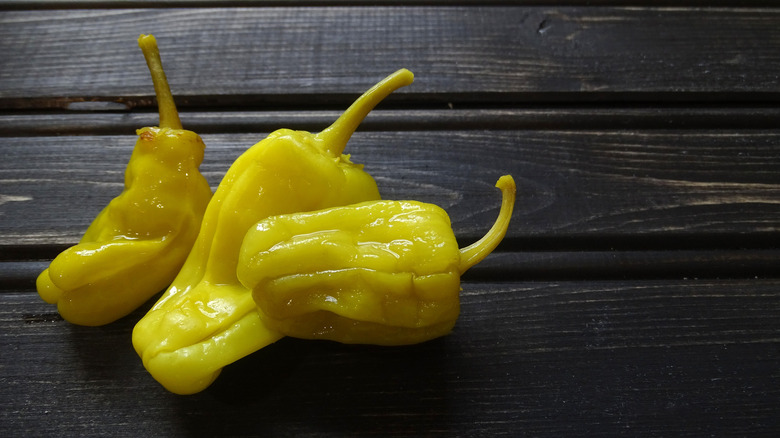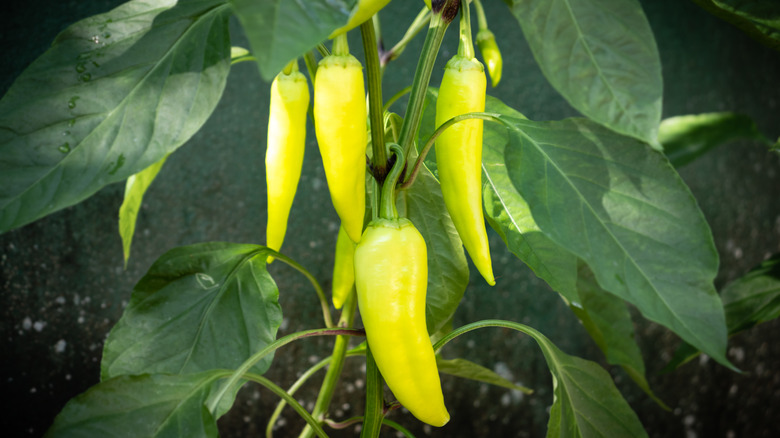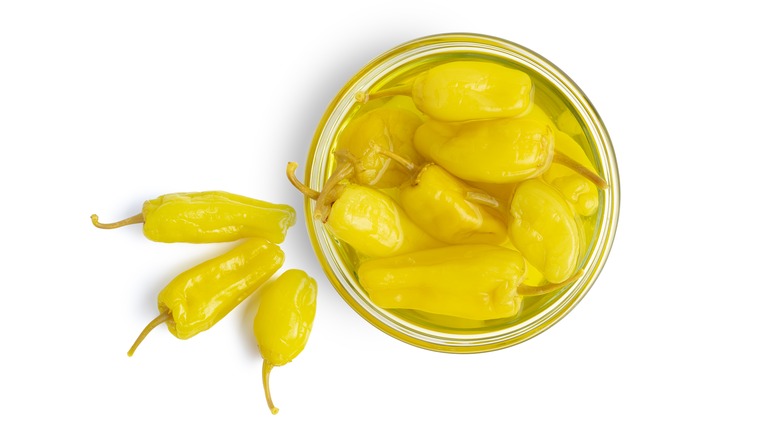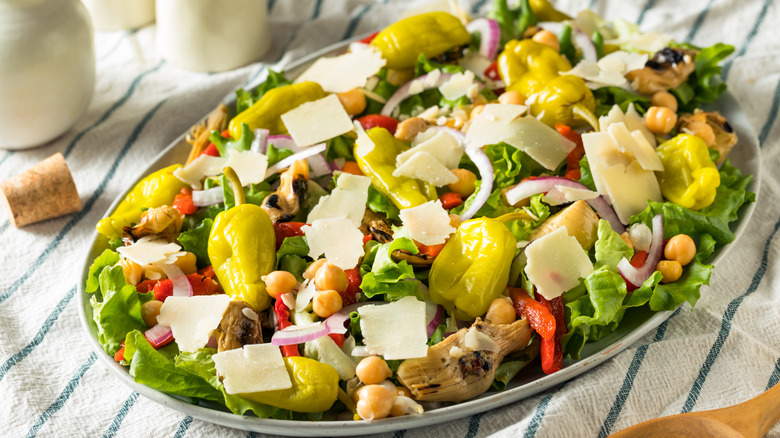The Difference Between Pepperoncini And Banana Peppers
Every good sandwich is incomplete without a bit of tang. And while onions and sour pickles may do the trick, there's nothing like adding a small, sweet, sour, slightly spicy green pepper to the mix to break up the richness of ingredients like meat, cheese, and mayo. But are we talking about banana peppers or pepperoncini?
There's no doubt the two are very similar — in fact, if you saw them both on the vine, you might not be able to tell the difference. Both peppers can appear yellow-green or green and have an elongated shape that is slightly curved at the bottom. If you bit into both, expect a sweet crunch with a burst of spicy, sour juice and seeds. They both belong to the species capsicum annuum, a class of peppers that also includes cayenne, shishito, serrano, and bell peppers. Considering their similarities, it's easy to mistake banana peppers and pepperoncini for each other, and amidst the layers of a big sandwich, you may not even know which one you're eating. However, these two peppers differ in a few key ways.
What are banana peppers?
Once you see a whole banana pepper, you'll understand exactly how it got its name. Also called banana chilis and yellow wax peppers, these little peppers are long, yellow, or yellow-green and slightly curved like the fruit that bears their name. That's where the similarities between bananas and these peppers end, however, as they have different flavors and textures and are not related at all. Banana peppers originally came from Hungary and are often mistaken for the much-spicier Hungarian wax peppers.
If you taste a banana pepper, however, you'll immediately realize that even those with a low spice tolerance can probably handle them. They are typically at least five times milder than a jalapeno and range from 0 to 500 on the Scoville heat scale, meaning that some banana peppers aren't spicy at all. They're typically sold as either hot or sweet, although most peppers are a combination of the two flavors and have some added sourness, especially if they're pickled. However, the riper a banana pepper is, the sweeter and milder it usually is.
Perhaps the most obvious difference between banana peppers and pepperoncini, at least from the outside, is in their skin. Banana peppers have smooth, waxy skin and a crunchy exterior, unlike pepperoncini.
What are pepperoncini?
While banana peppers are smooth and crisp on the outside, pepperoncini are wrinkly and usually sold jarred and pickled. Banana peppers typically have a pointy tip, but pepperoncini are generally round at the end and are about an inch smaller than banana peppers on average. Pepperoncini are also sweet, crunchy, and tangy, although they're usually more sour than banana peppers due to the vinegar used when pickling. Because they're mildly spicy, it's easy to mistake a banana pepper's flavor for a pepperoncini's, but these wrinkly peppers are typically a little spicier than their yellow siblings. For reference, pepperoncini usually range from 100 to 500 on the Scoville heat scale, meaning you won't find any that are completely mild.
And while banana peppers have Hungarian origins, pepperoncini come from Italy and Greece. They're also called golden Greek peppers, sweet Italian peppers, or friggitello by Italians. But although these two peppers came from different places, they have relatively similar nutritional value. Both peppers are high in vitamin C and iron, although pepperoncini also have fiber and calcium, while banana peppers are a good source of potassium and manganese. It's a good idea to watch your sodium consumption when eating pepperoncini, however — because they're almost always sold pickled; even three of the peppers can contain as much as 400 mg of sodium.
Can you use pepperoncini and banana peppers interchangeably?
The short answer is that it's completely fine to substitute banana peppers and pepperoncini for each other. Because both peppers showcase the same flavors, you may not even be able to tell the difference between the two in a multitude of recipes. They both work well on salads, pizza, tacos, nachos, toast, sandwiches, and even unique dishes like steak pizzaiola. In the Mediterranean, Italians and Greeks enjoy pepperoncini on antipasto platters and in arrabbiata sauce, although banana peppers would also add a similar brightness and acidity to these dishes.
It's important to note the slight difference in texture between the two peppers, however. Because banana peppers are smoother and sturdier, they're much better for stuffing than pepperoncini, which are too juicy and limp to hold toppings. Stuffing a banana pepper is similar to a jalapeno or even a bell pepper — just cut them in half, remove the seeds and insides, and fill with your toppings of choice. Also, pepperoncini are more commonly used as garnishes for drinks like Bloody Marys. Technically you could use banana peppers here, but they wouldn't bring the same pickled juiciness.
And for people who can't handle spice at all, you'll want to find mild banana peppers, as pepperoncini always have at least a little heat to them. But if you want a quick topping for your salad or sandwich, these two peppers can almost always be used interchangeably.



